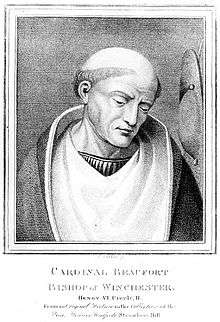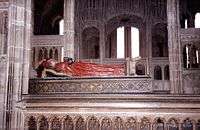Henry Beaufort
| His Eminence Henry Beaufort | |
|---|---|
| Cardinal, Bishop of Winchester | |
 Cardinal Henry Beaufort | |
| Province | Canterbury |
| Installed | 1404 |
| Term ended | 1447 |
| Predecessor | William of Wykeham |
| Successor | William Waynflete |
| Other posts | |
| Orders | |
| Consecration | 14 July 1398 |
| Created Cardinal |
24 May 1426 by Pope Martin V |
| Rank | Cardinal Priest |
| Personal details | |
| Born |
c. 1375 Château de Beaufort, Anjou, Kingdom of France |
| Died |
11 April 1447 Wolvesey Castle, Winchester, Kingdom of England |
| Buried | Winchester Cathedral |
| Denomination | Roman Catholic Church |
| Parents | John of Gaunt and Katherine Swynford |
| Previous post |
|
| Coat of arms |
 |


Henry Beaufort (c. 1375 – 11 April 1447) was a medieval English clergyman, Bishop of Winchester,[1] a member of the royal house of Plantagenet,[2] and a Cardinal of the Roman Catholic Church.[1]
Life
The second of the four children of John of Gaunt and his mistress (later wife) Katherine Swynford, Beaufort was born in Anjou, an English domain in France, and educated for a career in the Church. After his parents were married in early 1396, Henry, his two brothers and one sister were declared legitimate by Pope Boniface IX and legitimated by Act of Parliament on 9 February 1397, but they were barred from the succession to the throne.[3][4][5]
This later proviso was promulgated with the exact phrase excepta regali dignitate (English: the royal dignity excepted) by their half-brother Henry IV with dubious authority. On 27 February 1398, he was nominated Bishop of Lincoln, and on 14 July 1398, he was consecrated.[6] After Henry of Bolingbroke deposed Richard II and took the throne as Henry IV in 1399, he made Bishop Beaufort Lord Chancellor of England (as of 1403).[7] Beaufort resigned that position in 1404 when he was appointed Bishop of Winchester on 19 November.[8]
Between 1411 and 1413, Bishop Beaufort was in political disgrace for siding with his nephew, the Prince of Wales, against the king, but when King Henry IV died and the prince became King Henry V, he was made Chancellor once again in 1413, but he resigned the position in 1417.[7] Pope Martin V offered him the rank of Cardinal, but King Henry V would not permit him to accept the offer.
Henry V died in 1422, two years after he had married Catherine of Valois, daughter of King Charles VI, whom, in the Treaty of Troyes, had disowned his son Charles in favor of Henry. Henry and Catherine's infant son Henry VI, the Bishop's great-nephew, succeeded Henry as King of England, and, in accordance with the Treaty, succeeded Charles as King of France. Bishop Beaufort and the child king's other uncles formed the Regency Government of England 1422-1437, and in 1424, Beaufort became Chancellor once more, but was forced to resign in 1426 because of disputes with the king's other uncles.[7]
Pope Martin V finally appointed Beaufort as Cardinal in 1426.[7] In 1427, he made him the Papal Legate for Germany, Hungary, and Bohemia, and directed him to lead the fourth "crusade" against the Hussites heretics in Bohemia. Beaufort's forces were routed by the Hussites at the Battle of Tachov on 4 August 1427.[9]
When the English captured Joan of Arc in 1431, Beaufort was present to observe some of the heresy trial sessions presided over by Bishop Pierre Cauchon of Beauvais. He was also present at her execution. Records claim that he wept as he viewed the horrible scene as she was burned at the stake. Beaufort continued to be active in English politics for years, fighting with the other powerful advisors to the king. He died on 11 April 1447.[8]
Affair and daughter
When Henry was Bishop of Lincoln, he supposedly had an affair with Alice FitzAlan (1378–1415), the daughter of Richard FitzAlan and Elizabeth de Bohun and the widow of John Charleton, 4th Baron Cherleton.
"Henry fathered an illegitimate daughter, Jane Beaufort, in 1402, who some make Alice's daughter. Both Jane and her husband, Sir Edward Stradling, were named in Cardinal Beaufort's will. Their marriage about 1423 brought Sir Edward into the political orbit of his shrewd and assertive father-in-law, to whom he may have owed his appointment as chamberlain of South Wales in December 1423, a position he held until March 1437."[10]
Citations
- 1 2 Miranda, Salvador. "Henry Beaufort". The Cardinals of the Holy Roman Church. Retrieved 19 April 2009.
- ↑ Rosenthal, Joel Thomas (1970). "The Training of an Elite Group: English Bishops in the Fifteenth Century". Transactions of the American Philosophical Society (New Series ed.). 60 (5): 7.
- ↑ Cokayne Complete Peerage Volume XII pp. 40–41
- ↑ Schofield, Nicholas; Skinner, Gerald (2007). The English Cardinals. Oxford, UK: Family Publications. p. 60. ISBN 978-1-871217-65-0.
- ↑ Williams, David (1996). British Royalty. London, UK: Cassell. pp. 240–41. ISBN 0-304-34933-X.
- ↑ Fryde, et al. Handbook of British Chronology p. 256
- 1 2 3 4 Fryde, et al. Handbook of British Chronology p. 87
- 1 2 Fryde, et al. Handbook of British Chronology p. 277
- ↑ Harriss, G.L. (1987). "Henry Beaufort, 'Cardinal of England'". Proceedings of the 1986 Harlaxton Symposium: England in the Fifteenth Century. Woodbridge, UK: Paul Watkins Publishing: 123–24.
- ↑ R. A. Griffiths, Conquerors and Conquered in Medieval Wales, 1994.
References
- Cokayne, George E. (1982). The Complete Peerage of England, Scotland, Ireland, Great Britain, and the United Kingdom, Extant, Extinct, or Dormant. XII (Microprint ed.). Gloucester, UK: A. Sutton. ISBN 0-904387-82-8.
- Fryde, E.B.; Greenway, D.E.; Porter, S.; Roy, I. (1996). Handbook of British Chronology (Third revised ed.). Cambridge, UK: Cambridge University Press. ISBN 0-521-56350-X.
Further reading
| Wikimedia Commons has media related to Henry Beaufort. |
- Harriss, G. L. "Beaufort, Henry (1375?–1447)". Oxford Dictionary of National Biography (online ed.). Oxford University Press. doi:10.1093/ref:odnb/1859. (Subscription or UK public library membership required.)
| Political offices | ||
|---|---|---|
| Preceded by Edmund Stafford |
Lord Chancellor 1403–1405 1413–1417 1424–1426 |
Succeeded by Thomas Langley |
| Preceded by Thomas Arundel | ||
| Preceded by Thomas Langley |
Succeeded by John Kemp | |
| Catholic Church titles | ||
| Preceded by Thomas Thebaud |
Dean of Wells 1397–1398 |
Succeeded by Nicholas Slake |
| Preceded by John Bokyngham |
Bishop of Lincoln 1398–1404 |
Succeeded by Philip Repyngdon |
| Preceded by William of Wykeham |
Bishop of Winchester 1404–1447 |
Succeeded by William Waynflete |
| Preceded by Alemanno Adimari |
Cardinal Priest of S. Eusebio 1426–1447 |
Succeeded by Richard Olivier de Longueil |
| Academic offices | ||
| Preceded by Philip Repyngdon |
Chancellor of the University of Oxford 1397–1399 |
Succeeded by Thomas Hyndeman |